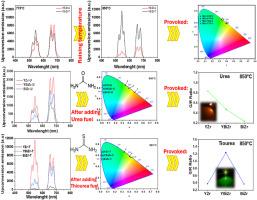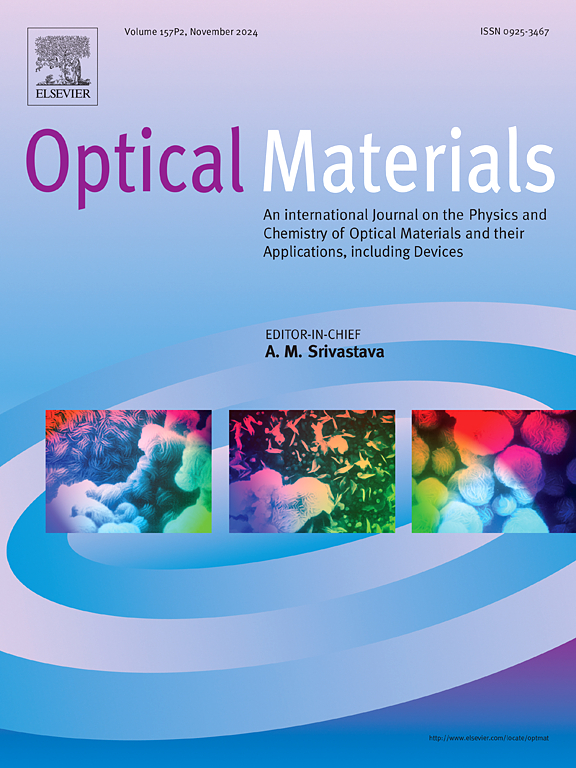尿素和硫脲对 (YxBi1-x)2Zr2O7:Er3+,Yb3+上转换荧光粉颜色发射的影响
IF 3.8
3区 材料科学
Q2 MATERIALS SCIENCE, MULTIDISCIPLINARY
引用次数: 0
摘要
本研究报告了 Bi2Zr2O7:Er,Yb (BiZr)、Y2Zr2O7:Er,Yb (YZr) 和 (Y0.25Bi0.75)2Zr2O7:Er,Yb (Y0.25Bi0.75Zr) 荧光粉的上转换发射特性。所有这些样品都是在 Er 和 Yb 浓度分别为 2 摩尔%和 20 摩尔%的条件下合成的。X 射线衍射分析表明,YZr 样品具有立方相,BiZr 样品具有单斜/立方相混合相,而 Y0.25Bi0.75Zr 样品则具有上述所有相的混合相。此外,电子显微镜分析表明,所有样品都是由形状不规则和准球形的颗粒混合形成的。合成 YZr、BiZr 和 Y0.25Bi0.75Zr 样品时使用了尿素或硫脲作为燃料,退火温度为 775 或 850 ℃。对于任何一种燃料,样品在受到 975 纳米波长的激发后,都会通过上转换产生绿色(525 和 548 纳米)和红色(655 纳米)发射。有趣的是,无论在任何燃料或合成温度下,Y0.25Bi0.75Zr 样品都能发出最强烈的辐射。有趣的是,用硫脲制成的 Y0.25Bi0.75Zr 样品的绿色发射强度比用尿素制成的样品高 49%,但用硫脲制成的样品的红色发射强度则低 25%。在某些条件下,可以观察到样品的颜色发射调谐:1)将退火温度从 775 或 850 ℃升高后,BiZr 样品(用尿素制成)的颜色发射从黄色变为橙红色;2)用硫脲代替尿素后,YZr 样品(退火温度为 775 ℃)的颜色发射从绿色变为红色。令人惊讶的是,尽管燃料或退火温度发生了变化,但 Y0.25Bi0.75Zr 样品始终保持绿色发射。总的来说,这项研究结果表明,可以利用不同的燃料或合成温度来增强上转换发射或调整发射颜色。这避免了以往文献中报道的使用高浓度稀土产生上述效果的情况。本文章由计算机程序翻译,如有差异,请以英文原文为准。

Effect of Urea and Thiourea on the color emission of (YxBi1-x)2Zr2O7:Er3+,Yb3+ upconversion phosphors
This study reports the upconversion emission properties of Bi2Zr2O7:Er,Yb (BiZr), Y2Zr2O7:Er,Yb (YZr) and (Y0.25Bi0.75)2Zr2O7:Er,Yb (Y0.25Bi0.75Zr) phosphors. All those samples were synthesized with fixed Er and Yb concentrations of 2 and 20 mol%, respectively. The analysis by X-ray diffraction revealed that the YZr sample had cubic phase, the BiZr sample had a mixture of monoclinic/cubic phases and the Y0.25Bi0.75Zr sample had a mixture of all the phases mentioned above. In addition, the analysis by electron microscopy indicated that all the samples are formed by mixtures of particles with irregular and quasi-spherical shapes. The YZr, BiZr and Y0.25Bi0.75Zr samples were synthesized using urea or thiourea as fuel and an annealing temperature of 775 or 850 °C. For any fuel, the samples produced green (525 and 548 nm) and red (655 nm) emissions by upconversion after exciting them with 975 nm. Interestingly, the Y0.25Bi0.75Zr sample always presented the most intense emission for any fuel or temperature of synthesis. Interestingly, the Y0.25Bi0.75Zr sample made with thiourea had a green emission intensity 49 % higher than that made with urea, but the red emission intensity was 25 % lower in the sample made with thiourea. Color emission tuning was observed in the samples under certain conditions: 1) the color emission for the BiZr sample (made with urea) was changed from yellow to orange-red after increasing the annealing temperature from 775 or 850 °C and 2) the YZr sample (annealed at 775 °C) changed its color emission from green to red after using thiourea instead of urea. Surprisingly, the Y0.25Bi0.75Zr sample always maintained its green emission despite the change of fuel or annealing temperature. In general, the results of this research demonstrate that different fuels or synthesis temperatures can be used to enhance the upconversion emission or to tune the emission color. This avoids the use of high concentrations of rare earths to produce any of these effects as previously reported in the literature.
求助全文
通过发布文献求助,成功后即可免费获取论文全文。
去求助
来源期刊

Optical Materials
工程技术-材料科学:综合
CiteScore
6.60
自引率
12.80%
发文量
1265
审稿时长
38 days
期刊介绍:
Optical Materials has an open access mirror journal Optical Materials: X, sharing the same aims and scope, editorial team, submission system and rigorous peer review.
The purpose of Optical Materials is to provide a means of communication and technology transfer between researchers who are interested in materials for potential device applications. The journal publishes original papers and review articles on the design, synthesis, characterisation and applications of optical materials.
OPTICAL MATERIALS focuses on:
• Optical Properties of Material Systems;
• The Materials Aspects of Optical Phenomena;
• The Materials Aspects of Devices and Applications.
Authors can submit separate research elements describing their data to Data in Brief and methods to Methods X.
 求助内容:
求助内容: 应助结果提醒方式:
应助结果提醒方式:


